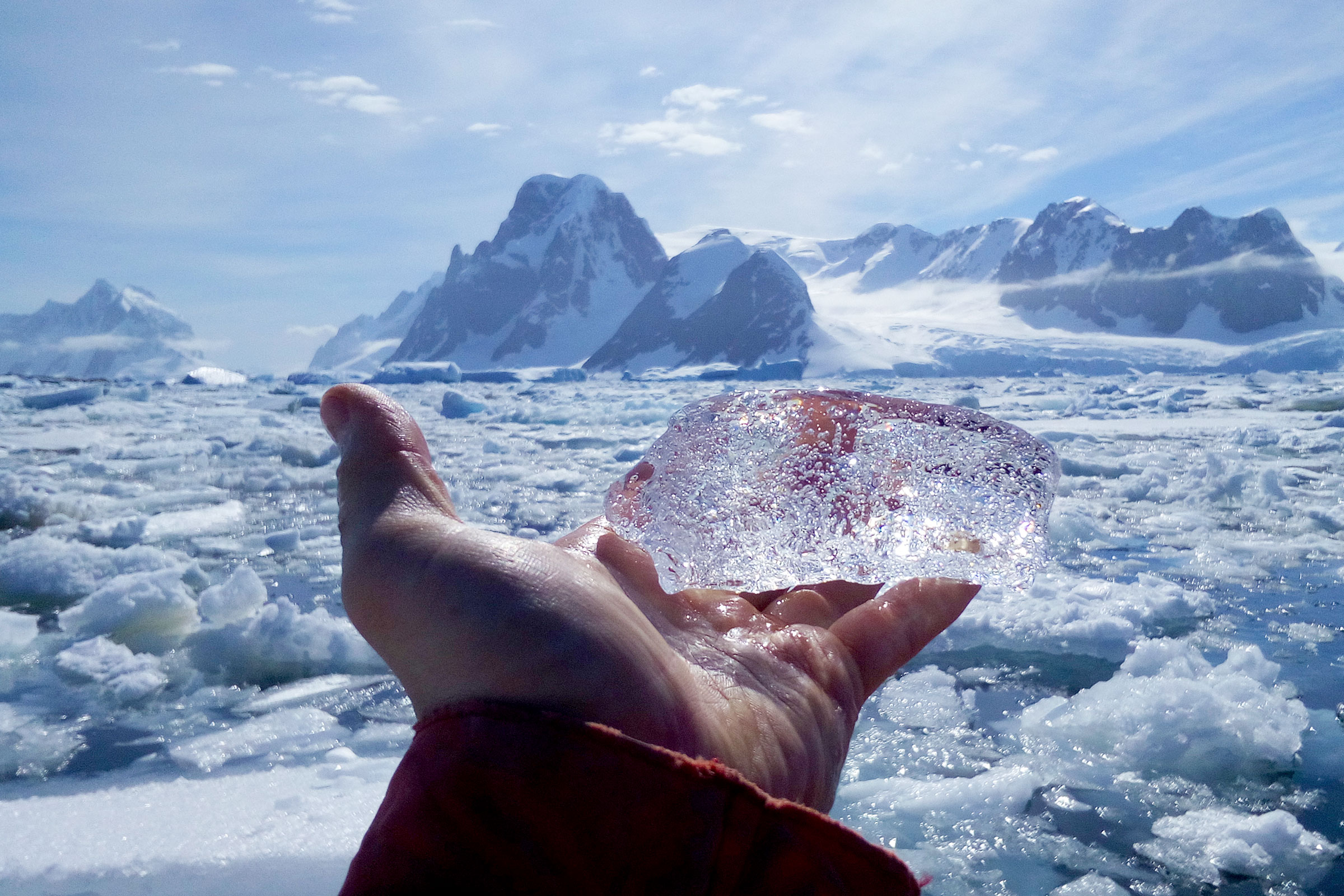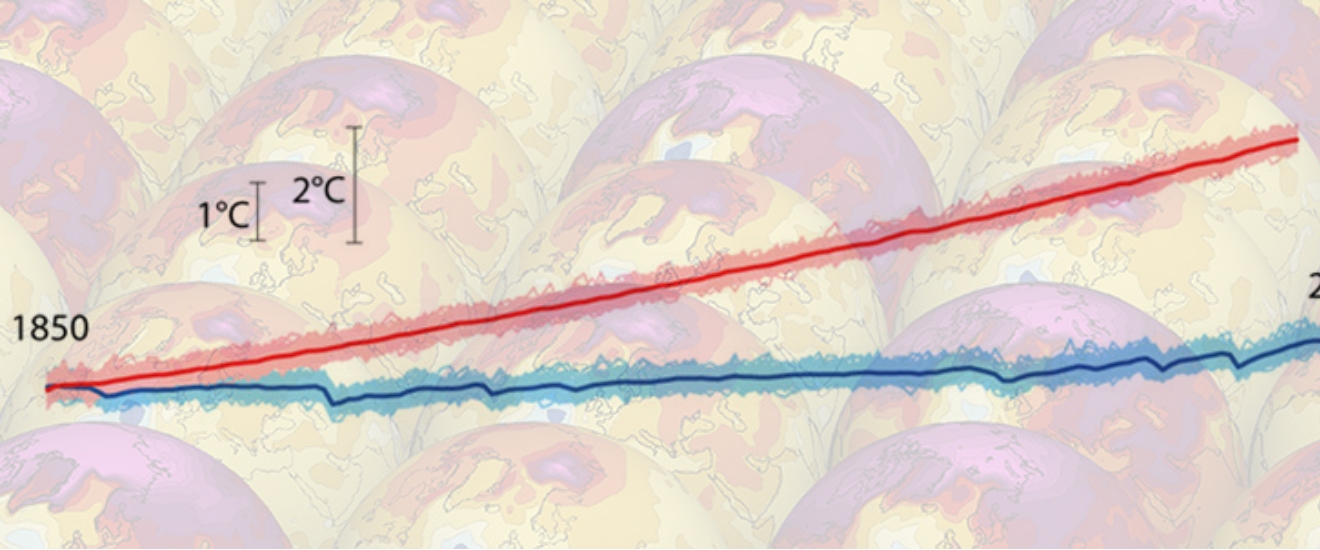How do I access and cite the MPI-GE data?
Atmospheric, land, sea-ice and ocean data (including some biogeochemistry variables) is currently available.
To use the data the license must first be accepted and can be found here.
Alternatively a direct download of any file will prompt the license agreement to appear. After the license is accepted the wget download will work. Please note that these scripts do not work when the safari browser is used.
The left hand side of the webpage can be used to search for variables as can the bar at the top. For example to search for precipitation in the RCP8.5 scenario one can put 'pr AND RCP8.5' into the search bar. The most efficient way to download the whole ensemble is to search for the data that you want then click 'Add all displayed results to Data Cart'. From here go into the Data Cart and click 'Select All Datasets' then create a wget script for that download. To run the wget script the following command can be used: $ bash wget-xxx.sh -H
The data will be available for 10 years from publication (end of 2028).
For scientists who wish to use the data before it is publicly available, we welcome collaboration with scientists based at the Max Planck Institute.
Please cite the following publication when using the data.
Maher, N., Milinski, S., Suarez-Gutierrez, L., Botzet, M., Dobrynin, M., Kornblueh, L., Kröger, J., Takano, Y., Ghosh, R., Hedemann, C., Li, C., Li, H., Manzini, E., Notz, N., Putrasahan, D., Boysen, L., Claussen, M., Ilyina, T., Olonscheck, D., Raddatz, T., Stevens, B. and Marotzke, J. (2019). The Max Planck Institute Grand Ensemble: Enabling the Exploration of Climate System Variability. Journal of Advances in Modeling Earth Systems, 11, 1-21. https://doi.org/10.1029/2019MS001639
Please send an email to grandensemble@mpimet.mpg.de if you publish a paper using the data, find any errors or bugs in the data or would like to request data that is not currently available.
The data is currently available on the native grid. We recommend CDO as a tool for regridding, selecting subregions, selecting time periods and much more. It is fast, efficient and can be used in scripting languages (bash, python) to easily loop over ensemble members. CDO can be found here.
Collaborative projects involving MPI
The SMILE (Single Model Initial-condition Large Ensemble) group was initiated together with colleagues from LMU Munich, University of Reading, and NCAR to provide a forum for exchange and discussion for the large ensemble community.
- The open SMILE mailing list can be found at https://large-ensemble.github.io/mailinglist/
- The 1st SMILE meeting was held as a splinter meeting at EGU 2019 (meeting summary PDF)
- There are currently monthly SMILE Webinars. Relevant information.
A special issue on large ensembles based on the EGU session on large ensembles can be found in Earth System Dynamics. This issue was open to submissions which exploited the new opportunities offered by large ensembles and explored how a combined analysis of the existing large ensembles can advance our knowledge in different fields. The special issue particularly invited submissions that use new methods to investigate these topics. More information and publications.
Publications
2015
-
Stevens, B. (2015). Rethinking the Lower Bound on Aerosol Radiative Forcing. Journal of Climate, 28(12), 4794–4819. doi:10.1175/JCLI-D-14-00656.1
2016
-
Bittner, M., H. Schmidt, C. Timmreck, and F. Sienz (2016). Using a large ensemble of simulations to assess the Northern Hemisphere stratospheric dynamical response to tropical volcanic eruptions and its uncertainty. Geophysical Research Letters, 43, 9324-9332. doi: 10.1002/2016GL070587
-
Rädel, G., T. Mauritsen, B. Stevens, D. Dommenget, D. Matei, K. Bellomo and A. Clement (2016). Amplification of El Niño by cloud long wave coupling to atmospheric circulation. Nature Geoscience, 9, 106-110. doi:10.1038/NGEO2630
2017
-
Hedemann, C., T. Mauritsen, J. Jungclaus, and J. Marotzke (2017). The subtle origins of surface-warming hiatuses. Nature Climate Change, 7(5), 336–339. doi:10.1038/NCLIMATE3274.
-
Olonscheck, D. and D. Notz (2017). Consistently Estimating Internal Climate Variability from Climate Model Simulations. Journal of Climate, 30, 9555-9573, doi:10.1175/JCLI-D-16-0428.1
-
Suárez-Gutiérrez, L., C. Li, P. W. Thorne and J. Marotzke (2017). Internal variability in simulated and observed tropical tropospheric temperature trends. Geophysical Research Letters, 44(11), 5709–5719. doi:10.1002/2017GL073798
2018
-
Dessler, A. E., T. Mauritsen and B. Stevens (2018). The influence of internal variability on Earth's energy balance framework and implications for estimating climate sensitivity. Atmospheric Chemistry and Physics, 18, 5147-5155, doi:10.5194/acp-18-5147-2018
-
Li, H. and T. Ilyina (2018). Current and future decadal trends in the oceanic carbon uptake are dominated by internal variability. Geophysical Research Letters, 45, 916-925. doi: 10.1002/2017GL075370
-
Maher, N., D. Matei, S. Milinski and J. Marotzke (2018). ENSO change in climate projections: forced response or internal variability? Geophysical Research Letters, 45, 11390–11298, doi:10.1029/2018GL079764
-
Manzini, E., A. Y. Karpechko and L. Kornblueh (2018). Nonlinear Response of the Stratosphere and the North Atlantic-European Climate to Global Warming. Geophysical Research Letters, 45, 4255–4263, doi:10.1029/2018GL077826
-
Niederdrenk, A. L. and D. Notz (2018), Arctic Sea Ice in a 1.5°C Warmer World. Geophysical Research Letters, 45(4), 1963–1971, doi: 10.1002/2017GL076159
-
Suarez-Gutierrez, L., C. Li, W. Müller and J. Marotzke (2018). Internal variability in European summer temperatures at 1.5°C and 2°C of global warming. Environmental Research Letters, 13(6) doi: 10.1088/1748-9326/aaba58
-
Zhang, L., W. Han and F. Sienz (2018), Unraveling Causes for the Changing Behavior of the Tropical Indian Ocean in the Past Few Decades. Journal of Climate, 31(6), 2377–2388, doi: 10.1175/JCLI-D-17-0445.1
2019
-
Maher, N., S. Milinski, L. Suarez-Gutierrez, M. Botzet, M. Dobrynin, L. Kornblueh, J. Kröger, Y. Takano, R. Ghosh, C. Hedemann, C. Li, H. Li, E. Manzini, D. Notz, D. Putrasahan, L. Boysen, M. Claussen, T. Ilyina, D. Olonscheck, T. Raddatz, B. Stevens and J. Marotzke (2019), The Max Planck Institute Grand Ensemble: Enabling the Exploration of Climate System Variability. Journal of Advances in Modeling Earth Systems, 28, 867–20, doi:10.1029/2019MS001639.
-
Marotzke, J. (2019). Quantifying the irreducible uncertainty in near‐term climate projections. WIRES Climate Change. 10:e563. doi:10.1002/wcc.563.
2020
-
D'Agostino, R., A.L. Scambiati, J. Jungclaus and P. Lionello (2020). Poleward Shift of Northern Subtropics in winter: Time of Emergence of Zonal versus Regional Signals. Geophysical Research Letters, 47, e2020GL089325. doi:10.1029/2020GL089325
-
Deser, C., F. Lehner, K.B. Rodgers, T. Ault, T.L. Delworth, P.N. DiNezio, A. Fiore, C. Frankignoul, J.C. Fyfe, D.E. Horton, J.E. Kay, R. Knutti, N.S. Lovenduski, J. Marotzke, K.A. McKinnon, S. Minobe, J. Randerson, J.A. Screen, I.R. Simpson and M. Ting (2020). Insights from Earth system model initial-condition large ensembles and future prospects. Nature Climate Change, 10, 277–286. doi:10.1038/s41558-020-0731-2
-
Hand, R., J. Bader, D. Matei, R. Ghosh and J. H. Jungclaus (2020). Changes of Decadal SST Variations in the Subpolar North Atlantic under Strong CO2 Forcing as an Indicator for the Ocean Circulation’s Contribution to Atlantic Multidecadal Variability. Journal of Climate, 33, 3213–3228, doi:10.1175/JCLI-D-18-0739.1
-
Huang, X., T. Zhou, A. Dai, H. Li, C. Li, X. Chen, J. Lu, J-S. Von storch and B. Wu (2020). South Asian summer monsoon projections constrained by the interdecadal Pacific oscillation. Science Advances, 6(11). doi:10.1126/sciadv.aay6546
-
Keil, P., T. Mauritsen, J. Jungclaus, C. Hedemann, D. Olonscheck and R. Ghosh (2020). Multiple drivers of the North Atlantic warming hole. Nature Climate Change, 10, 667–671. doi:10.1038/s41558-020-0819-8
-
Koenigk, T., L. Bärring, D. Matei, G. Nikulin, G. Strandberg, E. Tyrlis, S. Wang and R. Wilcke (2020). On the contribution of internal climate variability to European future climate trends. Tellus A: Dynamic Meteorology and Oceanography, 72(1) 1-17. doi:10.1080/16000870.2020.1788901
-
Lang, A. and U. Mikolajewicz (2020). Rising extreme sea levels in the German Bight under enhanced CO2CO2 levels: a regionalized large ensemble approach for the North Sea. Climate Dynamics, 55, 1829–1842. doi:10.1007/s00382-020-05357-5
-
Lehner, F., C. Deser, N. Maher, J. Marotzke, E. Fischer, L. Brunner, R. Knutti and E. Hawkins. (2020). Partitioning climate projection uncertainty with multiple Large Ensembles and CMIP5/6. Earth System Dynamics, 11, 491-508. doi:10.5194/esd-11-491-2020
-
Maher, N., F. Lehner and J. Marotzke. (2020). Quantifying the role of internal variability in the climate we will observe in the coming decades. Environmental Research Letters. doi:10.1088/1748-9326/ab7d02
-
Mauritsen, T. and E. Roeckner (2020). Tuning the MPI‐ESM1.2 global climate model to improve the match with instrumental record warming by lowering its climate sensitivity. Journal of Advances in Modeling Earth Systems, 12, e2019MS002037. doi:10.1029/2019MS002037
-
Olonscheck, D., M., Rugenstein and J. Marotzke (2020). Broad consistency between observed and simulated trends in sea surface temperature patterns. Geophysical Research Letters, 47, e2019GL086773. doi:10.1029/2019GL086773
-
Schlunegger, S., K.B. Rodgers and J.L. Sarmiento, T. Ilyina, J.P, Dunne, Y. Takano, J.R. Christian, M.C. Long, T.L. Frölicher, R. Slater, and F. Lehner (2020). Time of Emergence and Large Ensemble Intercomparison for Ocean Biogeochemical Trends. Global Biogeochemical Cycles, 34: e2019GB006453. doi:10.1029/2019GB006453
-
Suarez-Gutierrez, L., W. Müller, C. Li, and J. Marotzke (2020). Dynamical and thermodynamical drivers of variability in European summer heat extremes. Climate Dynamics, 54, 4351-4366. doi:10.1007/s00382-020-05233-2
-
Suarez-Gutierrez, L., W. Müller, C. Li and J. Marotzke (2020). Hotspots of extreme heat under global warming. Climate Dynamics, 55, 429–447. doi:10.1007/s00382-020-05263-w
2021
-
Giesse, C., Notz, D., & Baehr, J. (2021). On the origin of discrepancies between observed and simulated memory of Arctic sea ice. Geophysical Research Letters, 48, e2020GL091784. https://doi.org/10.1029/2020GL091784
-
Suarez-Gutierrez, L., Milinski, S. & Maher, N. (2021). Exploiting large ensembles for a better yet simpler climate model evaluation. Climate Dynamics. https://doi.org/10.1007/s00382-021-05821-w
Publications from external authors
2018
-
Bengtsson, L. and K. I. Hodges (2018), Can an ensemble climate simulation be used to separate climate change signals from internal unforced variability? Climate Dynamics. doi:10.1007/s00382-018-4343-8.
-
Plesca, E., V. Grützun and S. A. Buehler (2018). How Robust Is the Weakening of the Pacific Walker Circulation in CMIP5 Idealized Transient Climate Simulations? Journal of Climate, 31(1), 81–97. doi:10.1175/JCLI-D-17-0151.1.
2020
-
Brunner, L., C. McSweeney, A.P. Ballinger, D.J. Befort, M. Benassi, B. Booth, E. Coppola, H. de Vries, G. Harris, G.C. Hegerl, R. Knutti, G. Lenderink, J. Lowe, R. Nogherotto, C. O’Reilly, S. Qasmi, A. Ribes, P. Stocchi and S. Undorf (2020). Comparing Methods to Constrain Future European Climate Projections Using a Consistent Framework. Journal of Climate, 33, 8671–8692, doi:10.1175/JCLI-D-19-0953.1
-
Bódai, T., G. Drótos, M. Herein, F. Lunkeit and V. Lucarini (2020): The Forced Response of the El Niño–Southern Oscillation–Indian Monsoon Teleconnection in Ensembles of Earth System Models. Journal of Climate, 33, 2163–2182, doi:10.1175/JCLI-D-19-0341
-
Chemke, R. and L. Polvani (2020). Using multiple large ensembles to elucidate the discrepancy between the 1979–2019 modeled and observed Antarctic sea ice trends. Geophysical Research Letters, 47, e2020GL088339. doi:10.1029/2020GL088339
-
Dessler, A. E. (2020). Potential problems measuring climate sensitivity from the historical record. Journal of Climate, 33, 2237-2248, doi:10.1175/JCLI-D-19-0476.1
-
Díaz, L.B., R.I. Saurral and C.S. Vera (2020). Assessment of South America summer rainfall climatology and trends in a set of global climate models large ensembles, International Journal of Climatology, doi:10.1002/joc.6643
-
Fasullo, J. T., A. S. Phillips and C. Deser (2020). Evaluation of Leading Modes of Climate Variability in the CMIP Archives. Journal of Climate, 33, 5527–5545. doi:10.1175/JCLI-D-19-1024.1
-
Hassanzadeh, P., C.-Y. Lee, E. Nabizadeh, S. J. Camargo, D. Ma and L. Y. Yeung (2020). Effects of climate change on the movement of future landfalling Texas tropical cyclones. Nature Communications, 11,1. doi:10.1038/s41467-020-17130-7
-
Haszpra, T., D. Topál and M. Herein (2020). On the Time Evolution of the Arctic Oscillation and Related Wintertime Phenomena under Different Forcing Scenarios in an Ensemble Approach. Journal of Climate, 33, 8, 3107–3124, doi:10.1175/JCLI-D-19-0004.1
-
Hawkins, E., D. Frame, L. Harrington, M. Joshi, A. King, M. Rojas, and R. Sutton (2020). Observed emergence of the climate change signal: From the familiar to the unknown. Geophysical Research Letters, 47, e2019GL086259. doi:10.1029/2019GL086259
-
Huang, X., T. Zhou, A. Turner, A. Dai, X. Chen, R. Clark, J. Jiang, W. Man, J. Murphy, J. Rostron, B. Wu, L. Zhang, W. Zhang and L. Zou (2020). The Recent Decline and Recovery of Indian Summer Monsoon Rainfall: Relative Roles of External Forcing and Internal Variability. Journal of Climate, 33, 5035–5060, doi:10.1175/JCLI-D-19-0833.1
-
Johnson, N. C., D. J. Amaya, Q. Ding, Y. Kosaka, H. Tokinaga and S.-P. Xie (2020). Multidecadal modulations of key metrics of global climate change. Global and Planetary Change, 103149. doi:10.1016/j.gloplacha.2020.103149
-
Landrum, L. and M.M. Holland (2020) Extremes become routine in an emerging new Arctic. Nature Climate Change. doi:10.1038/s41558-020-0892-z
-
Merrifield, A. L., L. Brunner, R. Lorenz, I. Medhaug, and R. Knutti (2020). An investigation of weighting schemes suitable for incorporating large ensembles into multi-model ensembles, Earth System Dynamics, 11, 807–834, doi:10.5194/esd-11-807-2020
-
Topál, D., Q. Ding, J. Mitchell, I. Baxter, M. Herein, T. Haszpra, R. Luo and Q. Li (2020). An Internal Atmospheric Process Determining Summertime Arctic Sea Ice Melting in the Next Three Decades: Lessons Learned from Five Large Ensembles and Multiple CMIP5 Climate Simulations. Journal of Climate, 33(17) 7431-7454. doi:10.1175/JCLI-D-19-0803.1
-
Topál, D., I.G. Hatvani and Z. Kern (2020). Refining projected multidecadal hydroclimate uncertainty in East-Central Europe using CMIP5 and single-model large ensemble simulations. Theoretical and Applied Climatology. doi:10.1007/s00704-020-03361-7
-
Wills, R. C. J., D. S. Battisti, K. C. Armour, T. Schneider and C. Deser (2020). Pattern Recognition Methods to Separate Forced Responses from Internal Variability in Climate Model Ensembles and Observations. Journal of Climate, 33, 8693–8719, doi:10.1175/JCLI-D-19-0855.1
-
Zhou, T., J. Lu, W. Zhang and Z. Chen (2020). The sources of uncertainty in the projection of global land monsoon precipitation. Geophysical Research Letters, 47, e2020GL088415. doi:10.1029/2020GL088415
2021
-
Christiansen, B. (2021). The blessing of dimensionality for the analysis of climate data. Nonlin. Processes Geophys., 28, 409–422, https://doi.org/10.5194/npg-28-409-2021
-
Klavans, J.M., Cane, M.A., Clement, A.C. et al. (2021). NAO predictability from external forcing in the late 20th century. NPJ Clim Atmos Sci. 4, 22. https://doi.org/10.1038/s41612-021-00177-8
Contact
Dr. Daniel Klocke
Group leader – Computational Infrastructure and Model Development
Phone: +49 (0)40 41173-144
daniel.klocke@mpimet.mpg.de
More Content

When Neptune nudges dominoes: How the Southern Ocean controls global climate feedbacks
A study by Kang et al. proposes a new hypothesis for the anomalous slowdown in the rate of average global surface warming between 1979 and 2013. Often…

An oscillating wind system in the tropical stratosphere: future evolution and new projections
The “quasi-biennial oscillation” (QBO) is a well-known wind system characterized by alternating layers of westerly and easterly winds encircling the…



